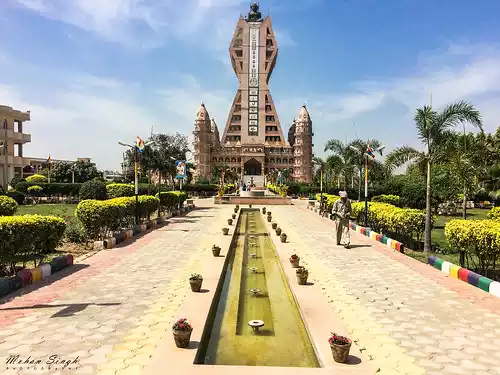Bagpat: A Comprehensive Overview
Introduction
Bagpat, a district in the Indian state of Uttar Pradesh, holds a significant place in the region's history, culture, and socio-economic landscape. With a unique blend of ancient heritage and modern development, Bagpat offers an intriguing study for historians, travelers, and researchers alike. This article delves into the various facets of Bagpat, providing an in-depth description of its geography, demographics, culture, cuisines, history, notable personalities, and administrative setup.
Geography of Bagpat
Bagpat is strategically located in the western part of Uttar Pradesh, sharing its border with Haryana. The district covers an area of approximately 1,321 square kilometers. It is part of the National Capital Region (NCR), which enhances its connectivity and economic significance.
Topography and Climate
The district predominantly features a flat terrain with fertile alluvial soil, making it ideal for agriculture. The Yamuna River flows along its western boundary, contributing to the rich agricultural landscape. Bagpat experiences a humid subtropical climate with hot summers, a monsoon season, and cool winters. The average annual rainfall is around 700 mm, primarily during the monsoon months of June to September.
Demography
Bagpat has a diverse and dynamic population. According to the 2011 Census, the district has a population of approximately 1.3 million people. The population density stands at around 983 people per square kilometer.
Population Composition
The district exhibits a mix of various communities and religions. Hindus constitute the majority, followed by Muslims, Sikhs, and a small percentage of other religions. The literacy rate in Bagpat is about 70%, with a noticeable improvement over the past decade due to educational initiatives.
Urban and Rural Divide
Bagpat has a predominantly rural character, with about 85% of the population residing in villages. The remaining 15% live in urban areas, including the district headquarters, Bagpat city, and other small towns such as Baraut and Khekra.
Cultural Heritage
Bagpat boasts a rich cultural heritage that reflects its historical significance and diversity. The district is known for its traditional music, dance forms, and festivals that are celebrated with great enthusiasm.
Festivals
The major festivals celebrated in Bagpat include Diwali, Holi, Eid, and Dussehra. Each festival is marked by vibrant celebrations, traditional music, dance performances, and communal harmony. The annual fair at Baleni, known as Baleni Mela, is a significant cultural event attracting thousands of visitors from nearby regions.
Art and Craft
Bagpat is renowned for its traditional handicrafts, especially pottery and weaving. The local artisans create exquisite pottery items that are both functional and decorative. Weaving, particularly of rugs and durries, is another notable craft that has been passed down through generations.
Cuisine
The cuisine of Bagpat is a delightful blend of traditional North Indian flavors. The food is characterized by its rich and robust flavors, utilizing locally sourced ingredients.
Staple Foods
The staple diet in Bagpat includes wheat-based items such as chapatis and parathas. Rice, lentils, and seasonal vegetables are also commonly consumed. Dairy products like milk, ghee, and curd play a significant role in the daily diet.
Popular Dishes
Some popular dishes from Bagpat include:
- Aloo Puri: A dish made of deep-fried bread served with spicy potato curry.
- Chole Bhature: A combination of spicy chickpeas and fluffy deep-fried bread.
- Kachori: A deep-fried pastry filled with spiced lentils or potatoes.
- Peda: A traditional sweet made from condensed milk, sugar, and cardamom.
Historical Significance
Bagpat's history dates back to ancient times, with references in various historical texts and scriptures. The district has been a witness to significant historical events and has played a role in shaping the region's history.
Ancient Period
Bagpat is believed to have been established during the times of the Mahabharata, with historical records suggesting that it was part of the Kuru Kingdom. The region has several ancient sites and temples that provide insights into its early history.
Medieval Era
During the medieval period, Bagpat was under the rule of various dynasties, including the Mughals. The influence of Mughal architecture is evident in some of the old structures and monuments found in the district.
Modern History
In the modern era, Bagpat became a focal point during the Indian freedom struggle. Several freedom fighters from the district played a crucial role in the independence movement. Post-independence, Bagpat has seen substantial development in infrastructure, education, and agriculture.
Notable Personalities
Bagpat has been home to several notable personalities who have made significant contributions in various fields.
Freedom Fighters
- Baba Shahmal: A prominent freedom fighter who played a key role in the 1857 revolt against the British.
Scholars and Writers
- Mahashay Rajpal: A renowned publisher and writer known for his contributions to Hindi literature.
Politicians
- Ajit Singh: A prominent political figure who served as the Union Minister for Agriculture and was a significant leader in Uttar Pradesh politics.
Administration
The administrative structure of Bagpat is designed to ensure efficient governance and development. The district is divided into three tehsils: Bagpat, Baraut, and Khekra.
Governance
Each tehsil is further subdivided into blocks and villages for effective local administration. The district is governed by a District Magistrate (DM) who oversees the implementation of government policies and programs.
Infrastructure
Bagpat has witnessed significant improvements in infrastructure, including roads, healthcare facilities, and educational institutions. The development of the Eastern Peripheral Expressway has further enhanced connectivity and economic prospects.
Conclusion
Bagpat, with its rich history, cultural heritage, and strategic location, stands as a significant district in Uttar Pradesh. The blend of traditional and modern elements makes it a unique region with much to offer. From its ancient roots in the Mahabharata to its modern-day development, Bagpat continues to thrive as a vibrant and dynamic district. Whether you are interested in exploring its cultural festivals, tasting its delectable cuisine, or studying its historical significance, Bagpat promises a rewarding experience.
